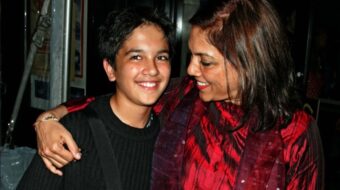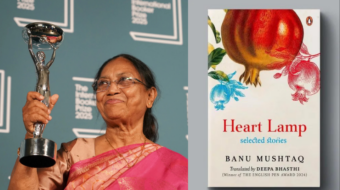As I was leaving the little state of Kerala recently I had to pass through a brief passport check by two Indian soldiers at the airport’s entrance doors. Glancing at my California address in the document, the Indian Army soldier smiled at me with a mocking twinkle in his eyes. “So, California – Governor Arnold Schwarzenegger, eh? The Terminator!” he laughed. Since I’d already spent 10 weeks in this land of 100 percent literacy and a highly politicized populace, this blatant teasing did not surprise me – just perhaps irked me a little bit. “Yes,” I retorted, “his muscles are in here,” pointing to my head, to the glee of this warrior of airport security and his comrade-in-arms. I did not begrudge their fun – they’ve certainly earned their political superiority. Kerala’s leaders have muscles in their bodies, and brains in their heads!
Shocking as it may be to most Americans, this little corner of India has a free, well-educated, equitable and relatively well-off society – all on one-seventieth of the average U.S. income. This has been achieved largely thanks to the hard work of the Communists. Red hammer-and-sickle flags abound! Here’s how they did it.
Stretching along the Indian Ocean, Kerala is a densely populated state on the southwest shore of India, way south of Mumbai and almost touching the very tip of the subcontinent, across from the island nation of Sri Lanka. Kerala (pronounced KER-a-la) is a land covered with coconut trees, dotted with tea and spice plantations, and dominated by mountains on its eastern edge, which drop down westward to the Indian Ocean, creating a huge alluvial plain of rivers, canals and inland seas – the Backwaters so loved by the tourists! I recently spent two-and-a-half months there and three weeks in the rest of India for comparison. Nowhere in Kerala can one find the huge income gaps, social unrest and deep levels of poverty found in the rest of India.
To call Kerala a socialist state is by-and-large an accurate description. Indian independence from British colonialism came in 1947, with state elections in distant Kerala organized in 1957. By all accounts, these electoral processes have been free, fair and democratic since their beginnings more than 50 years ago. It was in 1957 that the Communist Party of India’s leader in Kerala was voted in as chief minister of the state government, to the displeasure of the West, and of the centrist national government in New Delhi.
The initial victory of the Left in the late ’50s was firmly rooted in reality: the beginnings of largely successful land reform; strides toward free, universal education; a growing public health system; burgeoning workers’ and peasants’ cooperatives; militant trade unions; a vibrant women’s movement; and a frontal assault on the gross inequities of the caste system.
Today Kerala votes for its state and municipal governments every five years, with the Left Democratic Front (a coalition of parties with the CPI-M and CPI at its core) vying with the United Democratic Front (also a coalition, but led by the nation’s dominant political group, the Congress Party of the Nehru dynasty). Power has seesawed between the two Fronts for the past several decades, with a “now we want a change” attitude amongst the electorate every five years, shifting control from the left to the center and back again, but never to the right!
This highly democratic system has its sometimes humorous and frustrating drawbacks, with one Front starting projects and programs while in power, only to see them stalled and defunded when the other Front gains control and replaces them with a different agenda five years later. I was reminded of this as I scrambled around piles of bricks every time I walked down the main street of the small-scale, spread-out capital of Trivandrum (one Front had started a road-widening project, then the other halted work on it!).
There is sometimes literally a “demo-a-day” in Trivandrum. Every group and faction expresses itself without hesitation in Kerala! The prolific labor unions hold frequent strikes, as when I first visited in 2001 and stood on the narrow, crumbling ferry dock in Fort Kochi, watching the smiling members of the Muslim Boat Worker’s Union bob in the water, wearing life jackets and holding signs. They were demonstrating for a new dock. Not a bad thing. Sometime between my ’01 visit and my return in the fall of 2007, they got the new dock, to the benefit of workers and passengers alike.
India has 17 languages, and the one spoken in Kerala is Malayalam (a palindrome by the way!). Thus the inhabitants are more accurately called Malayali, rather than “Keralites.” Hindus make up about 60 percent of the population of 35 million, Muslims 20 percent and Christians 20 percent. While the rest of India is too often plagued by “communalism” (frequently violent conflicts between religious or ethnic groups), Kerala is distinctly peaceful. Mercifully, it has also been spared the horrible terrorist attacks of the past – and present – occurring elsewhere in the country.
To be fair to the rest of India, and the Developing World, Kerala has enjoyed certain advantages, both historic and recent, which have greatly enhanced its social and economic equality. Kerala has a history of progressive maharajas who instituted free, universal education. Women have generally had better status, due to an ancient system of matrilineal inheritance of property among some family clans. British colonialism largely overlooked out-of-the-way Kerala, and the Portuguese, who arrived first, left some positives, such as Catholic-style social service programs and schools. Today Malayalis often work abroad due to their higher educational and skill levels (the Persian Gulf states and even the San Jose area have lots!), and the money sent home greatly enhances the living standards of the whole state.
Some Westerners find Kerala’s particular brand of politics to be rather naïve and “cute.” Certainly I had to laugh when I met someone named “Stalin” (there tends to be a reluctance to let go of an uncritical admiration of Soviet-style communism). Isolated as they are, this can be excused; besides, Kerala’s implementation of Marxism and Leninism has been completely democratic and free – i.e. socialism at its best. Most importantly, nothing can take away from the hard work and remarkable achievements of this verdant land of socially conscious citizens.









